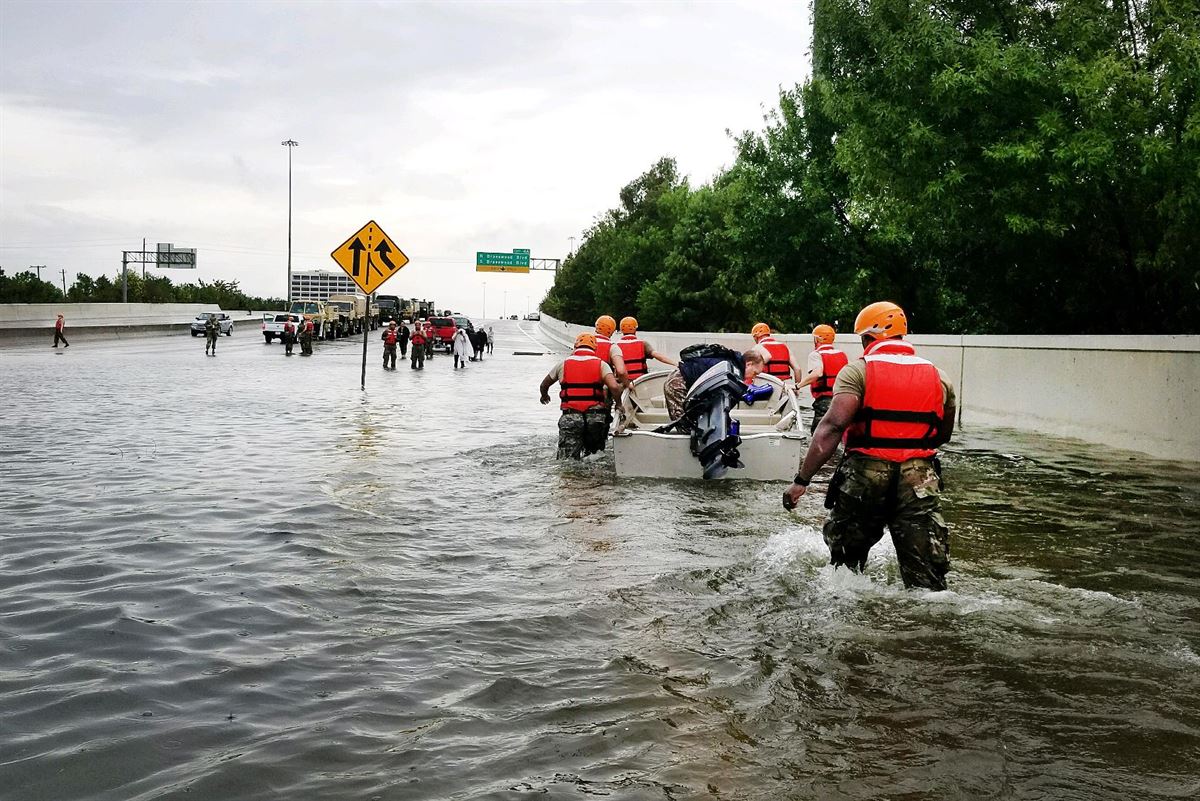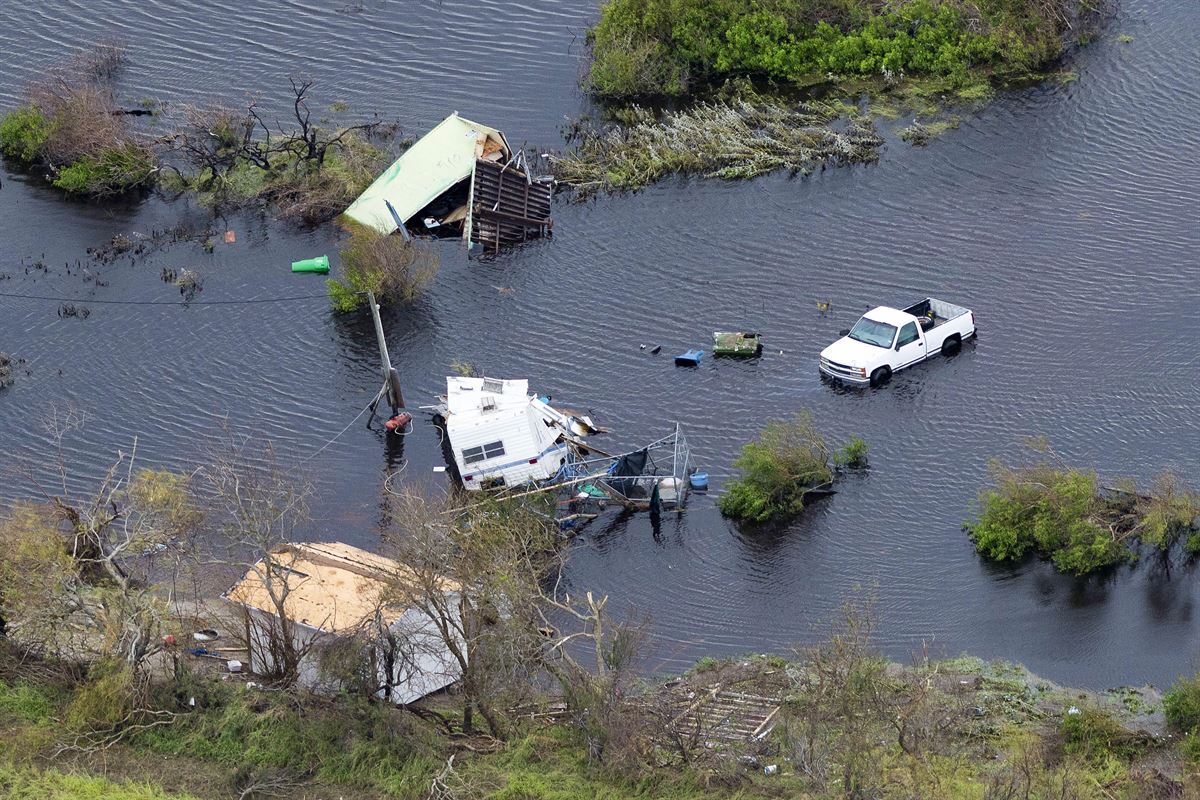By The Sabin Center for Climate Change Law

The onslaught of Hurricane Harvey has provoked a widespread reckoning with the foreseeability of such extreme events in the age of climate change, and with how institutionalized shortfalls in preparedness have contributed to the unfolding disaster. Flooding from Harvey’s tremendous rainfall has led to direct impacts on critical public infrastructure, private infrastructure, and millions of homes and businesses, including in many instances complete destruction, as well as secondary or spinoff effects, such as the release of toxic pollutants into the environment from industrial facilities in the hurricane’s path. All of this raises critical questions for climate change law and policy. Here, the team of lawyers at the Sabin Center offers a brief primer on eleven key climate law issues highlighted by and likely to arise due to Hurricane Harvey:
1. Disaster Recovery Legislation: As a presidentially-declared disaster area, Harris County, Texas is eligible for several forms of assistance pursuant to federal law. Federal disaster recovery legislation takes two basic forms. The first divides disaster mitigation and recovery responsibilities between the Federal Emergency Management Agency (FEMA) and the Department of Housing and Urban Development (HUD). The second is one-time appropriations that fund recovery efforts in disaster areas. These generally direct FEMA and HUD to spend on relief and recovery, but say little or (most often) nothing about ensuring that the long-term recovery effort involves preparations for the next storm. In the aftermath of Hurricane Sandy, this silence created problematic ambiguity for state and local actors who were eager to rebuild in a way that did not just restore what had been damaged or destroyed, but to create resilience to future flooding. Congress could easily dispel such ambiguity by including some key terms in a post-Harvey disaster appropriation bill. It could, for instance, provide funding for “long-term recovery including hazard mitigation based on the best available science.”
2. Flood Insurance Reform: The National Flood Insurance Program (NFIP) is in a bad way. Even before Hurricane Harvey struck, the Government Accountability Office identified the NFIP as being “high risk” in fiscal terms because, since Hurricanes Katrina and Rita struck in 2005, it has accrued debt to the Treasury—totaling just under $25 billion in July 2017—faster than it has been able to repay it. It is not hard to see how the NFIP got here. Even though the law requires most homeowners located in floodplains to, among other things, maintain flood insurance coverage, it also directs FEMA to keep that coverage “affordable.” Recognizing this problem, Congress instructed FEMA to raise premiums in the Biggert-Waters Act of 2012, but then reversed course after policyholders voiced opposition in the aftermath of Hurricane Sandy.
The Homeowner Flood Insurance Affordability Act of 2013 largely restored the situation to one in which the NFIP removes a disincentive (uninsurable flood risk) for those who would build, buy, or dwell in floodplains by shifting most of the costs of flood damage onto taxpayers. The newly appointed head of FEMA has voiced support for regulatory reform efforts that would use both sticks and carrots to encourage localities and individuals to avoid developing in floodplains and to invest more aggressively in hazard mitigation efforts. Legislative proposals of a similar bent—suggested in time for the NFIP’s September 30th legislative expiration and expected reauthorization—include a program to buy out the owners of “severe repetitive loss properties” rather than continuing to insure them. Enter Harvey, which struck a flood-prone city where only 15% of homeowners have flood insurance, and revealed undeniably how Houston’s boomtown-style development exacerbated its vulnerability to flooding. Congress would be right to look on Harvey as a tragedy to overcome, but also an object lesson about the need and opportunity to address the NFIP’s basic but fixable flaws.
3. Flood Maps: As part of its nationwide Coastal Flooding Risk Study Process, FEMA recently updated the Flood Insurance Rate Maps (FIRMs) for large portions of Harris County. The update led to significant expansions of FEMA-designated floodplains, meaning that 1) the statistical likelihood of flooding was recognized as being much higher than earlier FIRMs had depicted for large parts of the county, and 2) homeowners in those areas would be subject to the requirements of the NFIP, notably including compulsory purchase of flood insurance policies. However, as FEMA derives the probabilities embodied in FIRMs from historical evidence of flooding, even those updated FIRMs do not reflect the effects that climate change and rising sea levels are expected to have on flooding in the coming years. FEMA applies this rear-facing approach to estimates of flood risk nationwide, with one exception: New York City, which worked with FEMA to add an advisory “future conditions” layer to its maps to depict the effects of future sea level rise on flood risk. That layer is not “regulatory,” meaning that it does not affect FIRMs’ depiction of flood zones or the insurance rates affiliated with different zones. It is, however, informative, for anyone—developers, city agencies, investors, property owners—interested in understanding how flooding is likely to occur in the future and not just how it has occurred in the past. Harvey has revealed how warmer Gulf waters, a warmer atmosphere, and higher seas can boost a storm’s power and a storm surge’s height. What does Houston have to lose from following New York’s lead and working with FEMA to illustrate what rising sea levels likely mean for its future flood risks?[1]

4. Flood Protection for Federal Projects: Ironically, just ten days before Hurricane Harvey made landfall, triggering widespread flooding in south Texas, President Trump signed an executive order revoking the Federal Flood Risk Management Standard (FFRMS). Established by the Obama Administration in 2015, the FFRMS was intended to ensure federally-funded projects in and near floodplains are built to withstand the effects of future flooding, taking into account climate change. It required federal agencies to use a higher vertical flood elevation and expanded corresponding horizontal floodplain—i.e., compared to the current base flood elevation and floodplain—to address current and future flood risk for federal projects.
The FFRMS would have affected post-Harvey construction projects funded through federal disaster grants or loans. For example, as we previously reported, the Small Business Administration had proposed to update its disaster loan program to apply the FFRM to loans for the repair or replacement of damaged structures exceeding $2 million. The proposed update has, however, now been withdrawn. As a result, loans may be used to rebuild structures damaged by flooding due to Hurricane Harvey in a manner that fails to ensure they can withstand similar (or worse) floods in the future, despite the fact that climate change makes such floods more likely.
5. Controlling Air Emissions from Damaged Facilities: Hurricane Harvey has caused oil refineries to shut down or curb operations, and damaged the refineries themselves, both of which have resulted in the release of toxic air pollution. Some of these pollutants—namely carbon monoxide, lead, nitrogen dioxide, ozone, particulate material, and sulfur dioxide—are directly regulated by the Environmental Protection Agency (EPA) under regulations promulgated in 2015. The regulations require states to impose limits on facility emissions of covered pollutants during periods of startup, shutdown, and malfunction. It remains to be seen whether the releases from Harvey-affected refineries exceeded these limits but, if they did, the refineries could be subject to penalties for violations.
No penalties are likely to be imposed for releases of methane due to hurricane-related damaged gas storage tanks, pipelines, and/or other facilities. While there have not yet been any reports of such damage from Hurricane Harvey, it is a very real possibility given the extremely high winds and intense flooding seen. Nevertheless, even after the floodwaters recede, operators of storage and other facilities may not be required to find and fix methane leaks. Take leaks from gas pipelines, for example. Under federal regulations, pipeline operators are only required to repair leaks classified as hazardous, due to their proximity to buildings or other structures. Thus, to the extent that Hurricane Harvey caused leaks in populated areas (e.g., downtown Corpus Christi), repair would be required. However, hurricane-related leaks in more remote locations would not have to be repaired under the federal regulations, even if they release significant methane.
6. Handling Toxic Pollutants and Discharges of Toxic Water Pollution: Although no reports have yet been filed on this topic, the flooding caused by Hurricane Harvey has impacted industrial facilities, including oil and gas and chemical refineries, located along the Gulf of Mexico and other waterways. Flood-related discharges of toxic and conventional pollutants into waters of the U.S. exceeding effluent standards could violate facilities’ National Pollutant Discharge Elimination System permits and Section 402 of the Clean Water Act (CWA). The prospect of flood-related discharges could also point to failures to prepare adequate stormwater pollution prevention plans, and to appropriately handle hazardous pollutants under the Resource Conservation and Recovery Act (RCRA). Along these lines, the Conservation Law Foundation has filed two lawsuits in New England of note. On August 29, CLF filed a lawsuit claiming that Shell Oil has violated numerous provisions of the CWA by failing to take into account sea level rise, increased precipitation, or the increased frequency of storms at its facility at the Providence Terminal in Rhode Island. The lawsuit is similar to an earlier lawsuit CLF filed in Massachusetts against ExxonMobil, regarding its Everett Terminal outside Boston. In that case, CLF raises similar CWA issues, and further claims that the company is in violation of RCRA because it has failed to adapt the terminal to the imminent risks of storm surge and sea level rise, threatening the release of hazardous and solid wastes into nearby residential communities.
7. Chemical Safety: On August 31, an Arkema chemical plant in Crosby, about 30 miles north of downtown Houston, suffered several explosions. Early reports are that this is because certain chemicals required refrigeration, and the storm knocked out both the grid power and the backup generators. (This is reminiscent of what led to the Fukishima disaster, though thankfully not as serious.) Several petrochemical plants in the area were also reported to be releasing toxic chemicals into the air far above permit limits. All this highlights the importance of making sure that chemical plants can withstand foreseeable extreme weather events. The U.S. Chemical Safety Board has the responsibility of investigating such accidents, but President Trump proposesto eliminate it. EPA Administrator Scott Pruitt has also proposed a two-year delay in implementation of the Accidental Release Prevention Requirements for Risk Management Programs under the Clean Air Act. Several state attorneys general have instituted a lawsuit challenging this action.

8. Damage to Superfund Sites: There are sixteen federal Superfund sites in Harris County—more than any other county in Texas—as well as numerous Superfund sites located in adjacent counties and toxic waste sites managed under the state Superfund program. The extent of releases from these sites remains to be seen, but the risk is clear. In recent years, federal regulators have begun to assess the vulnerability of Superfund sites to flooding and sea level rise, but little has been done to remediate flood risks. For example, in 2012, EPA conducted a risk assessment in which it identified Superfund sites that might be vulnerable to the effects of climate change—specifically, those located within 1 and 1.5 meter sea level rise zones and 100- and 500-year floodplains. However, the assessment did not consider the risk of extreme precipitation at sites located outside of the 100- and 500-year floodplains (many of the facilities in Harris County are located very close to but not within these floodplains), nor did it compel any concrete action to reduce the risk of contamination during floods at the sites located in floodplains and sea level rise zones.
Due to the risks posed by climate change, some experts have recommended prioritizing the cleanup of toxic waste sites located in coastal areas vulnerable to sea level rise. Hurricane Harvey demonstrates that extreme precipitation events also pose a risk to facilities located further inland and outside of existing designated floodplains. To remediate risks at these sites, federal and state authorities can conduct cleanup directly and seek to recover costs from potentially responsible parties or compel them to perform the cleanup themselves. Either way, additional investments will be needed to prevent releases from toxic waste sites during flooding events. Going forward, risks from flooding should be considered in the selection of remedial measures for Superfund sites, and in the design of facilities for the storage, treatment or disposal of hazardous or solid wastes.
9. Zoning and Building Codes: Even if Houston were not located in the crosshairs of storms like Harvey, its largely unregulated development would still make its population and assets susceptible to floods. As ProPublica and The Texas Tribune explained in “Boomtown, Flood Town,” Houston’s rapid growth owes in part to its lax development and zoning restrictions. It is famously the only major U.S. city without zoning. This has led to houses popping up in and around flood plains, impervious pavement replacing pervious soils regardless of the implications for stormwater management, and the gobbling up of sponge-like prairie whose tall grasses can quickly draw rainwater from the surface and absorb it. The city’s growth has also outpaced its water management districts’ capacity to retrofit and scale up stormwater infrastructure.
Decisions must be made about how to rebuild. When the state and local governments affected by Hurricane Sandy faced similar decisions, they drew on New Orleans’ experience of Katrina and devised recovery programs aimed at building back better. These programs shifted people and structures out of flood plains (at least partially), redesigned buildings to reduce their vulnerability to flooding, and required planners to take climate change into account when authorizing proposals for long-lived projects.
10. Public utilities: — The Electric Reliabilty Council of Texas (ERCOT) regulates many aspects of the state’s electric power system, while the Public Utility Commission of Texas (PUCT) regulates other aspects of the power system as well as the telecommunications and water and sewer utilities. It is almost certain that much of the utility equipment in the area affected by Harvey has been damaged or destroyed, requiring enormous capital expenditures. Many of these expenditures will have to be approved by ERCOT or PUCT. In doing so, they should consider resilience to climate-related events — not only flooding but also extreme heat, which can also severely impair electric service and and will become an increasingly serious problem in Texas.
After Sandy, the New York State Public Service Commission approved a large storm hardening plan for Consolidated Edison Co., the principal electric utility company in New York City. It also required the company to retain climate scientists to study the effect that climate change would have on its service territory in the decades to come, and then to prepare and implement a plan to reflect those impacts in its capital and operational planning. That study is now underway. Similar efforts should be undertaken by ERCOT and PUCT to ensure the future resilience of the public utilities in Texas to climate-related events.
11. Climate Change Attribution and Hurricanes: Numerous scientists have suggested that Hurricane Harvey was fueled, at least in part, by the warming climate. This raises the question of whether greenhouse gas emitters or fossil fuel companies can be held liable for their contribution to climate change and the corresponding damages caused by Harvey. There have been a number of lawsuits seeking to hold emitters liable for the harmful effects of climate change, including three recent lawsuits in California brought by coastal communities against fossil fuel companies such as Chevron, ExxonMobil, BP, and Royal Dutch Shell for damages that the communities will incur as a result of sea level rise. The lawsuits allege that, among other things, these companies have created a state public nuisance through their knowing contribution to climate change, and that they should be held liable for negligence. At this point in the evolution of attribution science, it would likely be much more difficult to establish that damages incurred during a storm were caused by climate change, since scientists cannot yet say with a high degree of confidence that a particular storm would not have occurred in the absence of climate change nor can they determine with a high degree of certainty and precision the extent to which warming contributed to the severity of the storm. That said, as attribution science improves, lawsuits seeking damages for the incremental effects of climate change on storms and other extreme weather events such as heat waves may become viable if they can overcome the many other legal and practical hurdles such cases would face.
[1] FEMA’s Technical Mapping Advisory Council has recommended ways to incorporate the best available science of sea level rise into its flood mapping, but FEMA has not acted on those recommendations. New York State has adopted its own official sea level rise projections for use in infrastructure planning.
Romany Webb is a Research Scholar at Columbia Law School, Adjunct Associate Professor of Climate at Columbia Climate School, and Deputy Director of the Sabin Center for Climate Change Law.





